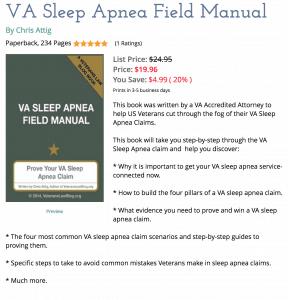How does the VA calculate the amount of money you will be paid when your military injury is service connected?
This is a question that not many Veterans know the answer to.
In a nutshell, the VA examines the medical evidence in your C-File, compares it to the impairment rating table, and assigns a percentage. That percentage is what drives your VA disability compensation payment.
Here’s how it works.
What are the VA Impairment Rating Tables?
The VA Impairment Rating Tables provide, in theory, a uniform way for the VA to fairly and consistently compensate Veterans who suffer from the same medical condition but who may not suffer from the same limitations in that condition.
A very common disability for Veterans is service-connected diabetes. The VA Rates – or assigns a disability percentage – for diabetes based on whether there is medical evidence relevant to the following criteria* (found at 38 C.F.R. § 4.119, Diagnostic Code 7913):
Diabetes managed by restricted diet: 10%
Diabetes requiring insulin AND restricted diet: 20% *
Diabetes requiring insulin AND restricted diet AND regulation of activities: 40%
Diabetes requiring insulin, restricted diet, regulation of activities, and 1-2 hospitalizations per year: 60%
After assigning a percentage, the VA rater than figures out the dollar amount of monthly compensation that correlates to that percentage, based on whether the Veteran is single, married, has children/dependents, etc. We all are familiar with the VA Compensation Rate Tables.
*It’s important to know that this is just an overview of Diagnostic Code 7913, for illustration purposes only. There are many more factors that can yield a higher or lower rating that I do not discuss here.
Where do you find the VA Impairment Rating?
The VA publishes the Impairment Ratings at 38 CFR Table 4, which is known as the VA Schedule for Rating Disabilities.
You can find it on the internet by doing a search for 38 CFR Table 4.
You can buy the paper version of the Code of Federal Regulations, Title 38, Parts 18-end (Pensions, Bonuses & Veterans Relief) Department of Veterans Affairs: Revised 7/13 at Amazon.com.
You can purchase a copy of the Code of Federal Regulations from the government (be prepared to shell out a few bucks and wait a few weeks)
You can also buy the 2013 Edition of Federal Veterans Laws, Rules and Regulations (2013) around the internet…be forewarned though, it carries a hefty $100+ price tag.
Here’s an option I like if you have a Kindle: Get Title 38, Code of Federal Regulations (Pensions, Bonuses and Veterans’ Relief), Volume 1 electronically and save some coin. You can also get the “Bible” in Kindle format: Federal Veterans Laws, Rules and Regulations, 2013 Edition
).
Once you get to 38 CFR Table 4, you will notice that it is hundreds of pages long.
The Table is broken down into 13 major body systems:
Musculoskeletal System
Organs of Special Sense
Impairment of Auditory Acuity
Respiratory System
Cardiovascular System
Digestive System
Genitourinary System
Gynecological conditions and Disorders of the Breast
Hemic and Lymphatic Systems
Endocrine System
Neurological Conditions and Convulsive Disorders
Mental Disorders
Dental and Oral Conditions
Each of those 12 major body systems is then broken into individual conditions, diseases, and disabilities within that body system.
For example, the Musculoskeletal System lists hundreds of conditions like arthritis, lumbar conditions, amputations of feet and hands, etc.
The Cardiovascular System lists dozens of conditions like Coronary Artery Disease, Valvular heart disease, Myocardial infarctions, and diseases of the arteries and veins.
[optinrev-inline-optin]
How do you figure out your VA Impairment Rating?
This is over-simplified to illustrate how the VA Impairment Rating Tables work.
But lets say that you are a Veteran of OIF (Iraq) or OEF (Afghanistan), and have a service-connected diagnosis of diabetes.
Diabetes is a condition that (largely) affects the Endocrine system. So you go to 38 CFR Table 4, and find that conditions of the Endocrine System are found at 38 CFR § 4.119.
You turn to 38 CFR § 4.119 and find that the rating criteria (what percentage relates to what medical evidence) for Diabetes Mellitus is listed under Diagnostic Code 7913.
Then, you match up your medical evidence to the rating criteria under Diagnostic Code 7913 until you get the appropriate rating.
Where does the VA get the medical evidence to determine your Impairment Rating?
From your C-File: they are bound by the evidence in your C-File in determining this rating. Most times, the evidence used to assess the Impairment Rating is provided by the VA Doctor that performs the Compensation and Pension Exam (although the VA must look at all the medical evidence in your C-File)
So, if you have a rating that is incorrect, or too low, then you can bet that it is because the right evidence was not in your C-File.
This is one reason – among dozens – that I believe that the C-File is the most important document in your VA disability compensation claim. It is so important that I have published an eBook showing you how to get a copy of your C-File.
Can a Veteran appeal the VA Impairment Rating decision?
Yes. If you think that the rating is too low, you can and should file a Notice of Disagreement (NOD) with this decision.
Most Veterans – believe it or not – do not know this. We are taught to challenge VA denials of service connection, but not denials of Impairment Rating.
In fact, my experience analyzing hundreds – if not thousands – of VA C-Files is that one of the most common VA errors that Veterans don’t appeal is the assignment of a VA Impairment Rating that is too low.
This is just a general overview of the VA Impairment Rating Tables – or as some folks call it, the VA’s Schedule for Rating Disabilities.
I regularly read and reply to the comments to these posts. So, let me ask you: what else you would like to know about the VA Impairment Rating Tables?







In the case of service connect diabetes, currently rated at 20%. As the condition progresses to require insulin, what does VA look at to substantiate “regulation of activities” and “restricted diet”? (Diabetes requiring insulin AND restricted diet AND regulation of activities: 40%)
Great Question, Robert….
Here’s what I would look at if it was my claim.
First, I would ask my doctor to write down any activities he/she doesn’t want me doing because of the Diabetes, and any diets he/she recommends I try.
Second, I would put together a list of before/after activities and diet – things I could do and eat before that I cannot now do or eat.
Then I’d turn the before/after list into a Sworn Declaration in sentence format. Before my diabetes diagnosis, I could eat “xyz food”. After diabetes, my doctor limits me to eating “abc”. Before my diabetes diagnosis, I could do “xyz activity”. After diabetes, my doctor restricts me from doing that activity.
I prefer to include both the doctor’s letter and the sworn declaration with the Veteran’s lay statements when I send my clients to the C&P Exam – and simultaneously add them to the C-File through the Evidence Intake Center: Lay evidence is the bullet, and medical evidence the rifle.
Hope that helps!
CA
Chris,
In many of your posts you state that the maximum impairment rating for diabetes is 10% unless you require insulin. You never mention the 20% rating for oral hypoglycemic agent and restricted diet.
Am I missing something?
Brian, you are right – a Veteran can get 20% under Diagnostic Code 7913 without taking insulin. I believe the post you were referring to was this one – I’ve cleared up the confusion and gave you a shout out for pointing this out to me! If you find any other posts that state that the 10% rating is the highest “non-insulin” rating for Diabetes, let me know so I can get them fixed. Thank you, sir!
Im at VA SHEVEPORT LA.Ive been sent here for knee replacement.insteed of bein put in hospital i was sent to salvation army.been tryn to get all my disablity for 4yrs.now broke stayin a homeless shelter
We talked on Google Plus yesterday, didn’t we? How did it go at the Shreveport VA Medical Center? Let me know your email and phone number – I’d like to talk to you. Send me an email at chris@attiglawfirm.com
Chris